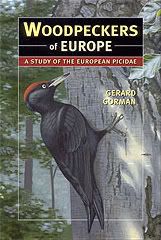Saturday, 26 January 2008
Middle Spotted Woodpecker: Voice
Middle Spotted Woodpecker Dendrocopos medius has a reportoire of calls, many quite unlike those made by its relatives. There is a distinct and diagnostic song made mostly, but not only, by males which is quite unlike those of any other European woodpecker. It is made throughout the breeding period but particularly just before laying, and occasionally in autumn and winter. It is usually composed of 4-10 slow-paced notes, though sometimes over 30 are made in a series and can perhaps be described as "kwah-kwah-kwah-kwah" or "kvar-kvar-kvar-kvar" or "gwarh-gwarh-gwarh-gwarh" or "gwaar-gwaar-gwaar-gwaar". It is a cat-like, meowing, whining, nasal, almost painful sounding "song" and is surprisingly far carrying. When establishing territory, courting or excited or annoyed, birds make this same song in a more rapid and strident manner. Sometimes just a single note or two is uttered. There is also a fair degree of individual variation. There is also a series of a rattling "ge-ge-ge-ge-ge" or "kik-kik-kik-kik-kik" notes, which to my ear recall a young Red-footed Falcon Falco vespertinus begging for food. THis is sometimes more like "kvek-kvek-kvek-kvek" and perhaps recalls some shorebirds, too. There is a slow but hysterical edge to this call and it is often uttered in a series, starting higher-pitched than it finishes, something like "kik-kik-kuk-kuk-kuk". There is a also a rattling call, a bit like that a call that Mistle Thrush Turdus vicivorus makes. These rattling calls may be contact calls and are made all year round. Though there is a typical single Dendrocopos "kik" or "kyk" call, softer than a similar call made by Great Spotted Woodpecker, most like Lesser Spotted Woodpecker, it is often rather feeble and not regularly made. A short, sharp "tek" or "teuk", again similar to other "pied" woodpeckers but lower pitched. Sometimes a Syrian Woodpecker-like "gug" is made, repeated and perhaps recalling Great Spotted Woodpecker but softer and lower pitched. Finally, there is a series of quiet, soft appeasement calls made between adults and recently fledged juveniles. Soon after fledging juveniles start to call like adults.
Subscribe to:
Post Comments (Atom)





1 comment:
Nice brief and this mail helped me alot in my college assignement. Thanks you on your information.
Post a Comment